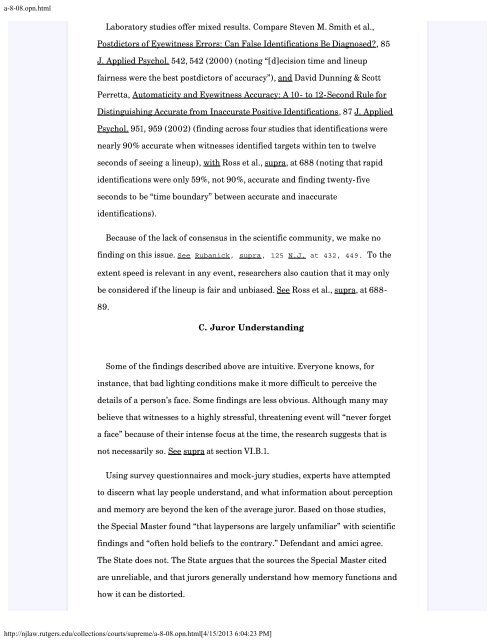State v. Henderson and the New Model Jury Charges - New Jersey ...
State v. Henderson and the New Model Jury Charges - New Jersey ...
State v. Henderson and the New Model Jury Charges - New Jersey ...
Create successful ePaper yourself
Turn your PDF publications into a flip-book with our unique Google optimized e-Paper software.
a-8-08.opn.html<br />
Laboratory studies offer mixed results. Compare Steven M. Smith et al.,<br />
Postdictors of Eyewitness Errors: Can False Identifications Be Diagnosed?, 85<br />
J. Applied Psychol. 542, 542 (2000) (noting “[d]ecision time <strong>and</strong> lineup<br />
fairness were <strong>the</strong> best postdictors of accuracy”), <strong>and</strong> David Dunning & Scott<br />
Perretta, Automaticity <strong>and</strong> Eyewitness Accuracy: A 10- to 12-Second Rule for<br />
Distinguishing Accurate from Inaccurate Positive Identifications, 87 J. Applied<br />
Psychol. 951, 959 (2002) (finding across four studies that identifications were<br />
nearly 90% accurate when witnesses identified targets within ten to twelve<br />
seconds of seeing a lineup), with Ross et al., supra, at 688 (noting that rapid<br />
identifications were only 59%, not 90%, accurate <strong>and</strong> finding twenty-five<br />
seconds to be “time boundary” between accurate <strong>and</strong> inaccurate<br />
identifications).<br />
Because of <strong>the</strong> lack of consensus in <strong>the</strong> scientific community, we make no<br />
finding on this issue. See Rubanick, supra, 125 N.J. at 432, 449. To <strong>the</strong><br />
extent speed is relevant in any event, researchers also caution that it may only<br />
be considered if <strong>the</strong> lineup is fair <strong>and</strong> unbiased. See Ross et al., supra, at 688-<br />
89.<br />
C. Juror Underst<strong>and</strong>ing<br />
Some of <strong>the</strong> findings described above are intuitive. Everyone knows, for<br />
instance, that bad lighting conditions make it more difficult to perceive <strong>the</strong><br />
details of a person’s face. Some findings are less obvious. Although many may<br />
believe that witnesses to a highly stressful, threatening event will “never forget<br />
a face” because of <strong>the</strong>ir intense focus at <strong>the</strong> time, <strong>the</strong> research suggests that is<br />
not necessarily so. See supra at section VI.B.1.<br />
Using survey questionnaires <strong>and</strong> mock-jury studies, experts have attempted<br />
to discern what lay people underst<strong>and</strong>, <strong>and</strong> what information about perception<br />
<strong>and</strong> memory are beyond <strong>the</strong> ken of <strong>the</strong> average juror. Based on those studies,<br />
<strong>the</strong> Special Master found “that laypersons are largely unfamiliar” with scientific<br />
findings <strong>and</strong> “often hold beliefs to <strong>the</strong> contrary.” Defendant <strong>and</strong> amici agree.<br />
The <strong>State</strong> does not. The <strong>State</strong> argues that <strong>the</strong> sources <strong>the</strong> Special Master cited<br />
are unreliable, <strong>and</strong> that jurors generally underst<strong>and</strong> how memory functions <strong>and</strong><br />
how it can be distorted.<br />
http://njlaw.rutgers.edu/collections/courts/supreme/a-8-08.opn.html[4/15/2013 6:04:23 PM]
















